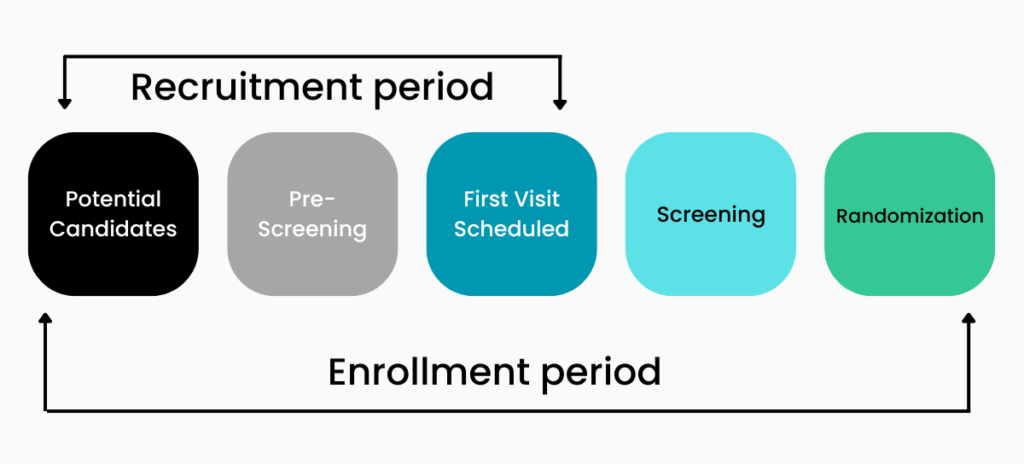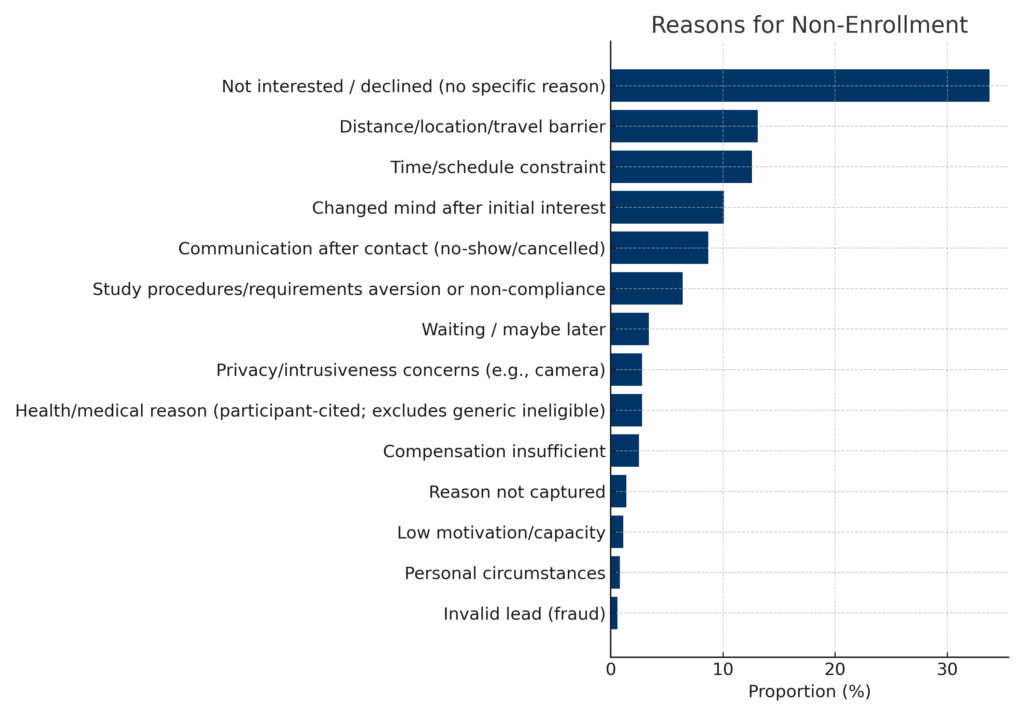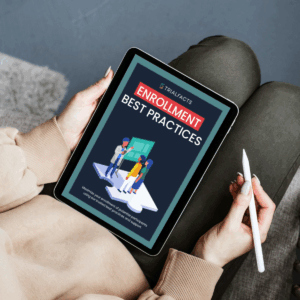The biggest risk isn’t finding interested candidates – it’s converting them. Recruitment builds the top of the funnel; enrollment determines whether studies stay on schedule.
Free resource: Get our Enrollment Best Practices Guide – a practical playbook with scripts, workflows, and metrics to convert qualified interest into participants. Download the guide here.
In this article, we’ll cover:
- The difference between recruitment and enrollment
- A funnel view of each stage and where drop-off happens
- Five key lessons to improve enrollment rates
- How better enrollment doubles results without extra recruitment
- A case study showing the impact of process changes
- Practical steps you can apply today to shorten timelines and save budget
Recruitment vs. Enrollment: Two Sides of the Funnel
Recruitment and enrollment are often lumped together, but they represent two distinct phases of the participant journey.

Recruitment brings people in:
Views study ad → Visits study website → Signs up → Passes online prescreen
Enrollment moves them forward:
Successfully contacted → Passes phone screening → Attends initial visit → Passes clinic screening & officially enrolls
If you’re using other recruitment strategies – like clinic referrals, call-in hotlines, community partners, registries, flyers, or QR codes – the initial steps may differ, but once contact is made, the enrollment process is generally the same.
A Closer Look at 2025 Enrollment Data
Out of 9,466 prescreen-qualified individuals, we analyzed 420 coded cases where participants chose not to continue. This gives a focused view of why reachable, interested people didn’t move ahead.

Here’s What We Found:
- Scheduling & availability issues (31%) – Limited clinic hours and inflexible screening slots were the single biggest barrier.
- Concerns about procedures or safety (24%) – Participants worried about risks, side effects, or misunderstood study requirements.
- Distance or travel barriers (18%) – Even with reimbursement, long travel times deterred participation.
- Changed mind / loss of motivation (15%) – Interest faded when there wasn’t enough follow-up or reassurance.
- Communication issues (12%) – Missed calls, lack of reminders, or inconsistent contact caused disengagement.
What This Tells Us
The problem isn’t just finding participants. It’s about keeping them engaged, reassured, and scheduled once they’ve shown initial interest.
Key Takeaways to Improve Enrollment
Based on the dataset above:
- Tackle scheduling upfront. With 31% citing limited hours as the top barrier, offering evening or weekend slots and faster scheduling options is critical.
- Address concerns openly. Nearly a quarter of participants (24%) hesitated due to safety worries or unclear procedures—surface these questions early and explain simply.
- Recruit closer to home. Travel and distance deterred 18% of participants, showing geography still matters even with reimbursements.
- Maintain motivation. Fifteen percent dropped off after initial interest; regular follow-ups and reassurance help prevent this.
- Keep communication consistent. Missed calls and irregular reminders (12%) led to disengagement, so a single point of contact and steady cadence builds trust.
To learn more, explore our Enrollment Best Practices for deeper insights and strategies.
Recruitment volume alone doesn’t guarantee results – conversion does. Here’s the math:
Study A: 100 participants recruited → 30% enrollment = 30 enrolled
Study B: 100 participants recruited → 60% enrollment = 60 enrolled
Result: Same recruitment, double the enrollments. And if you’re aiming for a fixed enrollment goal, improving conversion means you need about half as many participants recruited – so the recruitment timeline and budget are roughly cut in half.
Case Study: Doubling Screening Visits with Phone Screening
At one U.S. university site, Trialfacts applied its Enrollment Best Practices playbook. Within weeks saw these results:
1. Phone-screen pass rates jumped from 57% to 73%
2. Screening visits nearly doubled (2.4 → 5.0 per week)
3. Recruitment timelines shortened dramatically
The difference came not from more advertising, but from better enrollment processes.
How to Accelerate Enrollment Without More Recruitment
Our Enrollment Best Practices highlights four key areas every team can optimize:
Participant – Researcher Relationship
How do you turn a “maybe” into a committed yes—without a hard sell?
Contacting Participants
What cadence moves people from form fill to first conversation – without feeling pushy?
Phone Screening
How do you uncover concerns early and still end the call with the next step booked?
Avoiding No-Shows
What simple pre-visit sequence cuts last-minute drop-off?
These aren’t massive overhauls – they’re small, consistent shifts that reduce friction, keep participants engaged, and move more people from “interested” to “enrolled.”
Recruitment fills your funnel, but enrollment turns interest into impact.
By applying proven methods – personal relationships, flexible scheduling, clear communication, and structured follow-up – research teams can boost enrollment rates, shorten timelines, and save budget without needing more recruitment.




